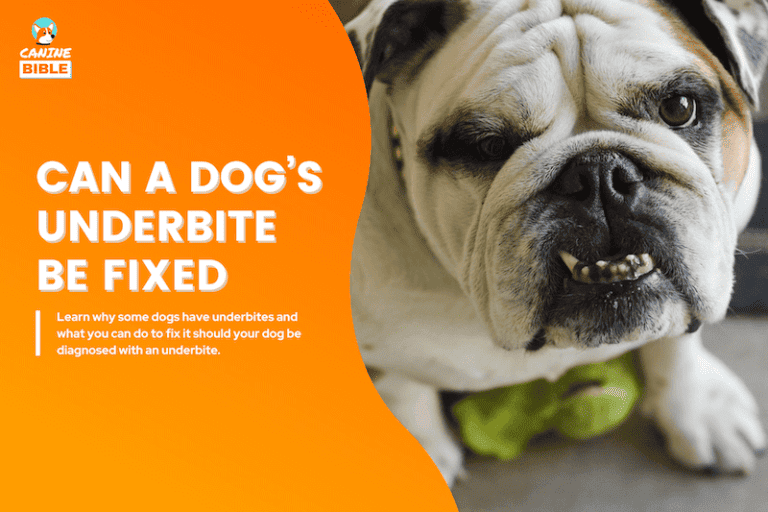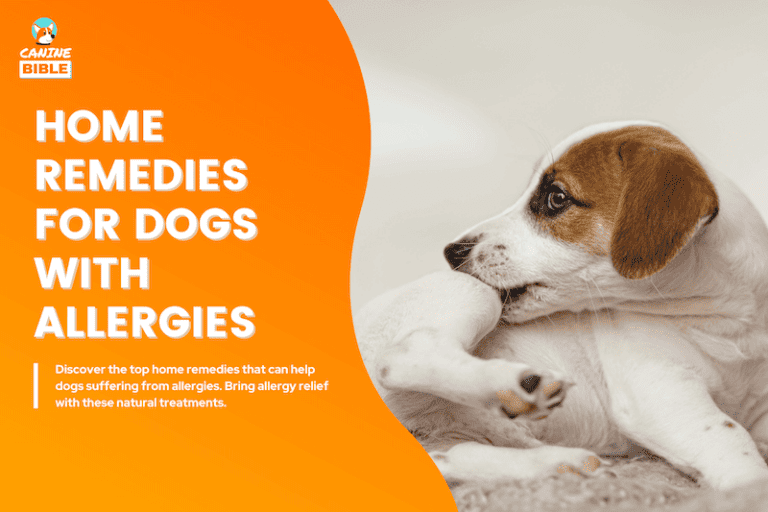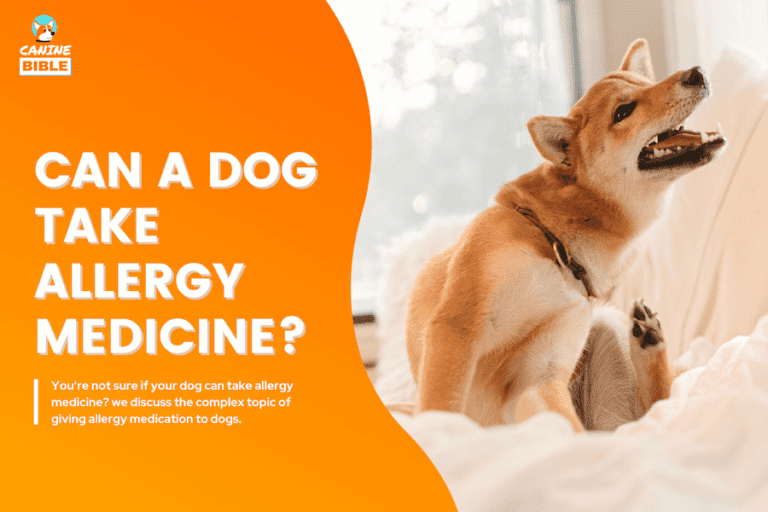Dog Food Allergy Testing & Diagnosis: What You Need to Know
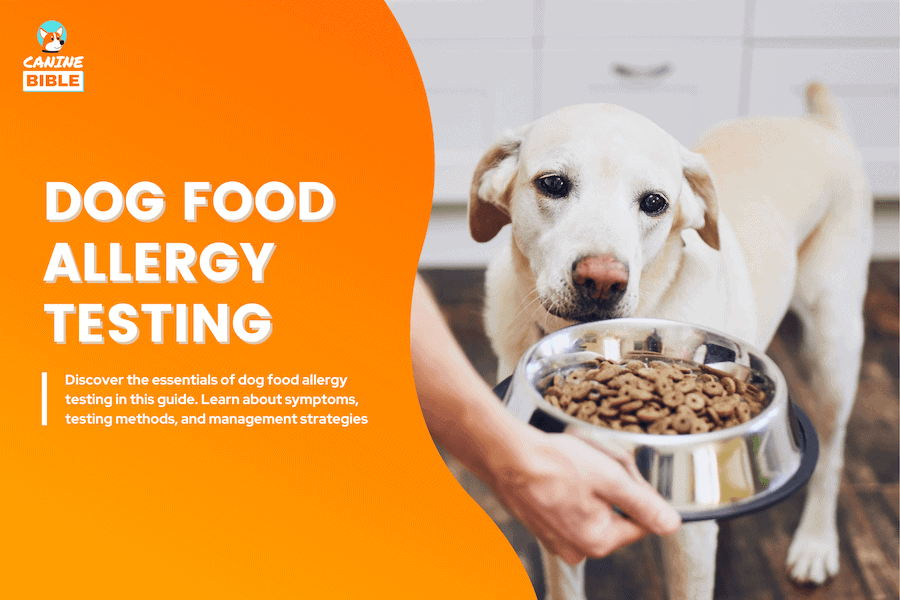
Canine Bible is reader-supported. We receive affiliate commissions via some of our links. This doesn’t affect rankings. Learn more.
Just like humans, some dogs exhibit immediate and obvious reactions to specific foods. For instance, a dog might eat a certain type of dog food or treat containing chicken and rapidly develop symptoms like itching or gastrointestinal upset. This immediate response makes it relatively straightforward for the owner to identify the allergen as being related to chicken.
However, in many cases, identifying the cause of a dog’s food allergy isn’t clear-cut. The symptoms of a food allergy in dogs can sometimes take hours or even days to manifest after ingesting the allergenic food. This delay makes it challenging for pet owners to pinpoint the exact food causing the reaction. It’s common for a dog to show signs of an allergy without any obvious changes in their diet or recent introduction of new foods, complicating the identification process further.
Luckily, different allergy testing methods are available to help you diagnose and manage food allergies in dogs, ensuring their health and comfort. Let’s dive in!

What Are Dog Food Allergies?
Dog food allergies are a type of adverse reaction that occurs when a dog’s immune system mistakenly identifies a specific ingredient in their food as a threat. It reacts by producing antibodies called Immunoglobulin E (IgE). These antibodies travel to cells that release chemicals, causing an allergic reaction that leads to symptoms such as itching, swelling, hives, or anaphylaxis in severe food allergies.
What Causes Dog Food Allergies?
Dogs’ food allergies are predominantly caused by proteins, especially dairy products, beef, lamb, chicken, eggs, soy, or gluten (from wheat). While proteins are the most common source of allergens, virtually any food ingredient can produce an allergy. Substances like additives, colorants, and preservatives can also be responsible.
There is ongoing research to identify what makes the immune system more likely to express that trait during early puppyhood. Puppies treated with antibiotics can be more susceptible to health problems like allergies later in life because antibiotics change the environment inside the gut, the largest immune organ in a dog’s body. Susan Wynn, an internationally known expert on holistic pet care and former president of the American Holistic Veterinary Medical Association, recommends that young puppies be on dog probiotics up to six months to one year of age and give them a diet that’s fairly high in variety.[1]
Most Common Dog Food Allergies
These are the top dog food allergens (allergies) according to BMC Veterinary Research, from most reported to least reported.
| Dog Food Allergen | Percentage of Dogs With Reported Reaction |
|---|---|
| Beef | 34% |
| Dairy Products | 17% |
| Chicken | 15% |
| Wheat | 13% |
| Soy | 6% |
| Lamb | 5% |
| Corn | 4% |
| Egg | 4% |
| Pork | 2% |
| Fish | 2% |
| Rice | 2% |
How Veterinarians Diagnose Food Allergies In Dogs
When suspecting a dog food allergy, the first crucial step is to consult a veterinarian, preferably a vet specializing in allergies. They will conduct a thorough evaluation to diagnose the condition accurately. Understanding what this process involves can be helpful for pet owners.
The veterinarian will start by gathering a detailed medical history of your dog. They will ask specific questions regarding the following:
These inquiries help the veterinarian determine the underlying cause of your dog’s symptoms. For instance, environmental allergens like pollen can sometimes cause reactions that mimic food allergies.
The veterinarian may suggest allergy tests, such as skin or blood tests, to identify potential food allergies. While these tests can indicate sensitivities to certain foods, they are not always definitive in diagnosing a true food allergy without a history of reactions. These tests provide insights into possible causes of symptoms but cannot conclusively diagnose a food allergy. In some cases, an elimination diet may be employed. This involves feeding the dog a diet free of suspected allergens for a period, then reintroducing foods one at a time to observe for reactions.
Consulting a dog allergist specializing in diagnosing and managing dog food allergies is essential. They will determine the most appropriate tests, confirm if a food allergy exists, and guide the management of the allergy once diagnosed. It’s necessary to follow their advice closely to ensure the health and well-being of your dog.
Dog Food Allergy Testing
Blood Testing
Blood testing for dog food allergies involves checking for specific antibodies in the dog’s blood produced in response to allergens. The test measures the level of Immunoglobulin E (IgE) antibodies to various food proteins. Blood tests can be a helpful tool in identifying potential allergens, but they are not always definitive. The results must be interpreted cautiously, as false positives can occur. The test is more effective when used with other diagnostic methods, like an elimination diet.
Skin Patch Testing
Skin patch testing, or intradermal testing, involves injecting small amounts of purified allergens into the dog’s skin. The test is usually conducted on a shaved area, typically on the side of the chest or abdomen. The reaction, usually in the form of a small bump or redness, is observed and measured. In some cases, skin patch testing can be more accurate than blood testing, but it also has limitations. It can be uncomfortable for the dog, and false positives are possible. Moreover, it requires skilled personnel to perform and interpret the results correctly.
The Gold Standard Dog of Food Allergy Testing: Eliminations Diet
While dog food allergy testing (blood and skin test) is recommended, it is not the gold standard according to the literature and veterinarians.[3],[4]
The elimination diet is considered the gold standard in diagnosing dog food allergies. It involves feeding the dog a diet with ingredients they have never eaten before (novel proteins) or a hydrolyzed protein diet, where the protein is broken down so the immune system doesn’t recognize it as an allergen. The diet must be strictly adhered to for a period, typically 8 to 12 weeks, without any other foods, treats, or flavored medications. If the symptoms resolve, it suggests a food allergy.
After the symptom-free period, the original foods are reintroduced into the dog’s diet, one ingredient at a time, with a gap of 1-2 weeks between each, to monitor for any allergic reaction. This step is critical to identify which specific ingredient(s) cause the allergic reaction. If the dog shows a return of allergic symptoms with the reintroduction of a particular food, this food likely contains the allergen. Once identified, this allergen should be permanently eliminated from the dog’s diet.
Based on the findings, a long-term diet plan is formulated to avoid the identified allergens. This may involve continuing the novel protein diet, using hydrolyzed protein diets, or selecting commercial foods that do not contain the offending allergens.
The choice of allergy testing method depends on various factors, including the dog’s condition, the veterinarian’s expertise, and the availability of testing options. It’s important to have a veterinarian guide this process to ensure accurate diagnosis and effective management of food allergies in dogs.
Dog Food Allergy Testing vs Intolerance Testing
Understanding the differences between food allergies and intolerances and their respective tests is key for dog owners seeking to address their pets’ dietary issues effectively. Proper testing ensures dogs receive a suitable diet, leading to better health outcomes.
Dog Food Intolerance Vs Dog Allergies
Dog food allergies occur when your dog’s immune system perceives a certain substance (allergen), like chocolate, as harmful, causing symptoms such as itching, swelling, hives, or anaphylaxis. Intolerances, however, do not involve the immune system. They usually stem from a dog’s inability to digest certain substances, like lactose, leading to gastrointestinal issues such as diarrhea. Intolerances can also be caused by environmental factors, such as new bedding or rugs that could trigger sneezing or itching in dogs.
Can Dog Food Intolerance Tests Help Deal With Dog Allergies?
Food allergies and food intolerances in dogs can have similar symptoms, often leading to confusion in distinguishing between the two. Testing your dog for food intolerances can help clarify whether they suffer from allergies or intolerance. This distinction is crucial for your vet to determine the appropriate treatment and necessary dietary adjustments.
Food allergies in dogs generally arise from prolonged exposure to a specific allergen. When dogs are fed the same food for a long time, they are continuously exposed to the same ingredients. If the dog is predisposed to developing allergies, this repeated exposure can increase the likelihood of an allergic reaction to one or more of those ingredients. Similarly, if your dog has intolerances, repeated exposure makes them worse over time. This is why vets sometimes recommend a varied or limited ingredient diet to help identify potential allergens and reduce the risk of developing allergies or worsening intolerances.
Testing for allergies and intolerances is helpful because both can occur in any dog breed and age. Knowing what foods your dog can’t tolerate or is allergic to can help you buy a safe formula and remove those ingredients from his diet that could otherwise cause more severe problems.
At-Home Dog Food Allergy Testing
At-home dog food allergy testing is a concept that has grown in popularity, offering a convenient way for pet owners to try to identify potential food allergens affecting their dogs. However, it’s important to understand the scope and limitations of these tests. The scientific community has questioned the accuracy and reliability of at-home allergy tests. They are not considered as reliable as tests conducted by veterinarians, such as blood tests, skin tests, or elimination diets. However, at-home tests may provide some insights but are limited in their ability to diagnose food allergies definitively. They are more likely to identify food sensitivities or intolerances than true allergies.
Dog Food Allergy Test Types
Here is how these four different types of food allergy tests work.
| Saliva | Hair | Blood (RAST test) | Skin (Intradermal Skin) | |
|---|---|---|---|---|
| Where to Take | At-Home | At-Home | Veterinarian | Veterinarian |
| Sedation Required | No | No | No | Yes |
| Risk | No | No | No | Yes |
| Price | Affordable | Affordable | Costly | Costly |
| Best Test | EasyDNA Dog Allergy Test | 5Strands | N/A | N/A |
| Procedure | Non-Invasive | Non-Invasive | Invasive | Invasive |
Why Is Dog Food Allergy Testing Important
About 1-2% of all dogs have a food allergy.[5] Neglecting food allergies can lead to serious health complications. True dog food allergies cause an immune response that can result in symptoms, including:
It’s rare, but a severe reaction resulting in anaphylaxis can also occur, similar to severe peanut allergies in humans.
Most dogs with food allergies appear to be pruritic (intense itching). The most often reported cutaneous manifestations of an AFR are recurrent bacteria, yeast skin infections, external otitis, and atopic dermatitis, which can all happen in the same dog.[6] In fact, as many as 25% of dogs with skin problems have a food allergy.
Dr. Justin Shmalberg, DVM at Nom Nom, says, “Usually, animals don’t die from a food allergy, but it does affect their quality of life. If they’re itching all the time, it can feel like having a thousand mosquito bites. While that’s not as catastrophic as organ failure, it can be pretty hard on the dog.”
Because food allergies and sensitivities typically cause itchy skin, your dog’s constant scratching, biting, and licking of the affected area could open up his skin to yeast, bacterial, or other secondary infections. In worse cases, excessive licking can turn into a condition known as lick Granuloma, also known as acral lick dermatitis. This problem occurs when a dog licks at one spot for hours daily, eventually creating a wound at the site. The wound stimulates further licking, and the dog begins a cycle of self-trauma, inflammation, and infection.
Bowel movements are also affected by food allergies. A study showed that non-allergic dogs have around 1.5 bowel movements per day, whereas some dogs with food allergies may have three or more per day.
Common Body Parts Affected By Food Allergies
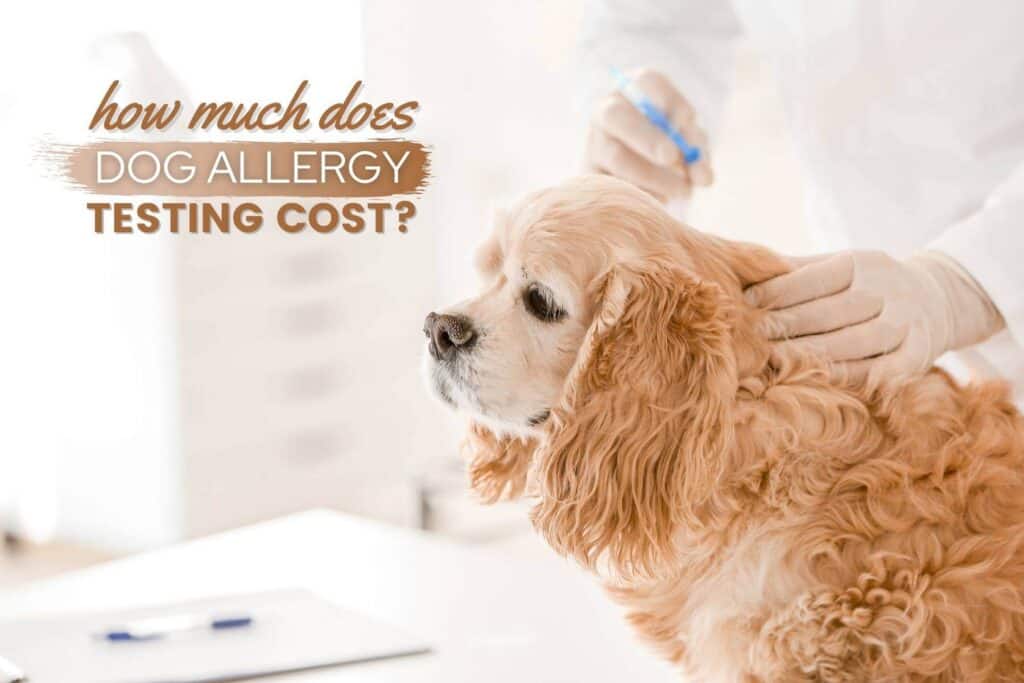
Dog Food Allergy Testing Cost
Prices can vary significantly based on geographic location. Pet insurance might cover some of these costs, depending on your policy. According to Petplan, a pet insurance company, the bill may be over $1000. Their claims data from this pet insurance company show that one insured pet exceeded $5,000 in allergy-related care.[7] On the other hand, at-home dog allergy tests are far less expensive, typically priced between $88 to $212.
It’s important to discuss the most suitable testing method for your dog and the associated costs with your veterinarian. They can help you weigh the costs against the potential benefits and accuracy.
Breeds Prone to Food Allergies
Some dog breeds are more prone to develop food allergies. If your dog is on this list, it’s wise to take extra precautions for his diet. Dr. Wynn says in her experience that German Shepherds, Dachshunds, and Cocker Spaniels are the most commonly affected dog breeds.
Out of 22 research papers on AFR, four breeds (German shepherd dogs, West Highland white terriers, Labrador, and golden retrievers) accounted for about 40% of affected dogs. While dog food allergies are multi-factorial, a genetic predisposition factor exists in dogs’ development.
Here are the top 10 breeds most frequently Googled along with the term “food allergies” or “dog food allergies,” which may indicate these breeds are typically experiencing food allergy issues. It also supports Wynn and the research about breeds prone to allergies.
- Dachshunds
- Bulldogs
- Golden Retrievers
- German Shepherds
- Pugs
- Pitbulls
- Cocker Spaniels
- Shih Tzus
- Westies (aka West Highland White Terriers)
- Yorkies (aka Yorkshire Terriers)
What Is The Best Medicine For Dog Food Allergies?
Food allergies can wreak havoc on a dog’s body if not addressed. If your pup is currently struggling with food allergies, you’re likely wondering what you can give Fido for relief. Our experts show you the safest and most effective allergy treatments to help your dog in our Best Allergy Medicine for Dogs article. You can also explore our homemade allergy meds for dogs guide.
Frequently Asked Questions
Are Dog Food Allergy Tests Worth It? Alternatives
If you’re among the many dog owners struggling to find the right food for your dog, or if you have a pup at home itching due to allergies, there are several steps you can take to find a solution. Starting with an elimination diet is often the best approach. Although this process can be tedious, it’s the recommended method for diagnosing dog food allergies. Dog allergy testing can be helpful by identifying potentially harmful ingredients, but it’s important to interpret the results cautiously and always consult your veterinarian. Since dog food allergies can develop to almost any protein or carbohydrate ingredient over time, it’s advisable to provide a diet with some variety, allowing for a natural rotation. This practice helps maintain good gut health.
There are multiple food alternatives to manage or prevent food allergies in dogs. The most commonly known option is a hypoallergenic diet, often called hydrolyzed dog food, which usually requires a prescription from your vet. Other choices include vegan dog food, raw dog food, and homemade dog food. Many dog owners have had success with these options, so it’s worthwhile to explore them further. Treats can also be a source of your dog’s food allergies. Vegan dog treats and freeze-dried dog treats are excellent alternatives for dogs with allergies.
Typically, puppies under one-year-old don’t experience environmental or other allergies as frequently. If your dog exhibits skin and gastrointestinal symptoms, it might be due to food allergies. Your veterinarian can discuss the best options for your pet based on the results of any allergy testing.
Like It? Subscribe & Share!
Sources
Canine Bible uses only high-quality sources, including peer-reviewed studies, to support the facts within our articles. Read our editorial process and product review methodology to learn more about how we fact-check, test products, and keep our content accurate, reliable, and trustworthy.
- Fetch
- BMC Vterinary Research
- Veterinary Practice News
- Tufts University
- PetMD
- BMC Veterinary Research
- PetPlan
Canine Bible authorship represents the unified voice of our entire editorial team and our in-house veterinarians rather than a single author. Each article, blog post, and review published under the Canine Bible name undergoes a rigorous review process, involving all team members to guarantee accuracy and up-to-date in accordance with the latest veterinarian research. This collaborative effort is an integral part of our editorial process and aligns with our four pillars of content creation. This approach ensures our content is backed by expert knowledge and factual information, offering our readers reliable, actionable, and trustworthy content.


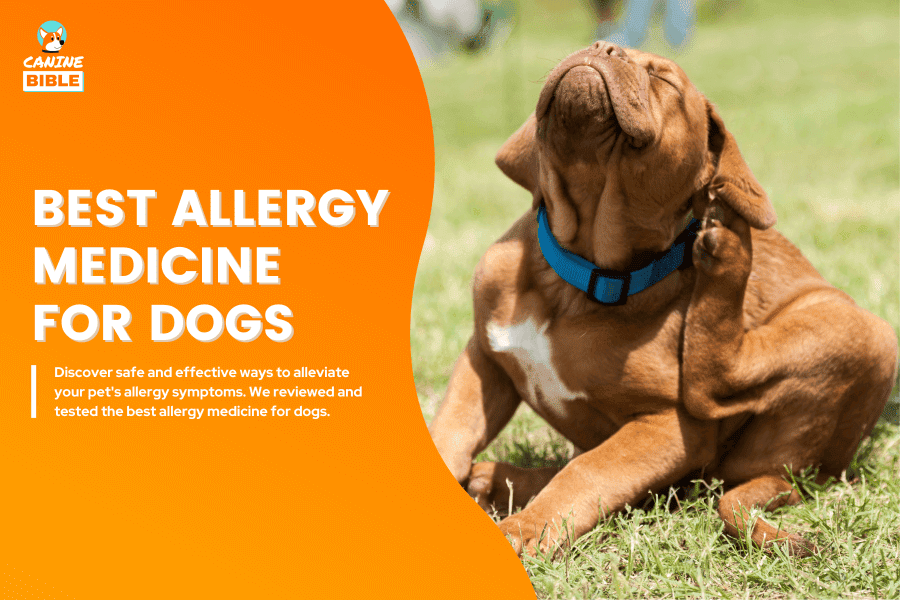


![Dog Allergy Testing Cost: How Much Will You Pay? [Update 2024]](https://www.caninebible.com/wp-content/uploads/2022/08/how-much-does-dog-allergy-testing-cost-768x512.jpeg)

